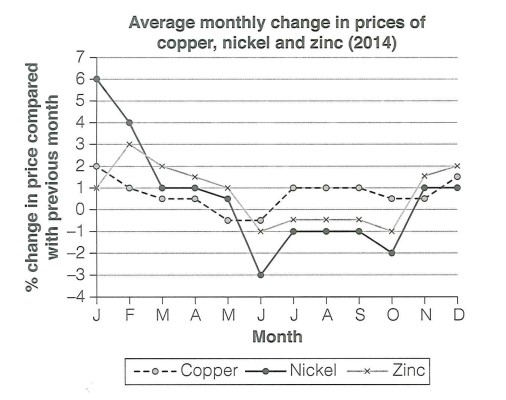Cùng IELTSITY tìm hiểu bài mẫu Ielts Cambridge 18 – Writing test 4 (bao gồm Task 1 và Task 2) ngay nhé!

Writing Task 1: Line Graph
The line graph represents the average percentage change in the price of copper, nickel, and zinc throughout the months of 2014.

Overall, the price change of all nickel and zinc were fairly volatile throughout the surveyed period. Notably, while nickel recorded the highest percentage change, Copper recorded the lowest.
For nickel, the percentage change in the price of this metal compared with the previous month started at an all-time high of 6% in January, before plummeting to a record low of negative 3% in June. The price decrease slowed down to negative 1% in July, then remaining constant until September. In the last 3 months of 2014, it fluctuated and finished at positive 1% in December.
Turning to copper, while its price change trended downward in the first half of the year, dropping from 1% to about negative 0.5%, it rose back to just over 1% in the last 6 months, despite some fluctuations between September and November.
Lastly, the percentage change of zinc saw a small increase from 1% to 3% after the first month of 2014, followed by a steady decline to negative 1% in June. This figure hovered between approximately negative 0.5% and 1% between June and October, whereas it consistently rose from negative 1% to 2% in the last three months of the year.
Writing Task 2:
In many countries, people are now living longer than ever before. Some people say an ageing population creates problems for governments. Other people think there are benefits if society has more elderly people. To what extent do the advantages of having an ageing population outweigh the disadvantages?
| Essay | Useful Language |
| There are two opposing schools of thought regarding an ageing population. While some claim that the elderly population is a burden1 for society, others argue that old people can still bring many benefits. In this essay, I shall discuss both the merits and the drawbacks of this demographic trend before going on to state that the overall effect of this trend will vary across different countries.
The experience and wisdom that the elderly have accumulated2 from overcoming hardships and setbacks throughout their lives can be an invaluable source of guidance for young people. This is particularly useful in the workplace as both young and veteran employees will have a lot of opportunities for intergenerational collaboration3 and provide unique perspectives on an issue, leading to effective problem-solving. Furthermore, after retiring, many elderly people still actively participate in volunteering and community projects, which can help boost social cohesion4 and the wellbeing of others in society.
Nonetheless, an increasing ageing population also has several negative implications for society. Firstly, the need for healthcare increases as people get older so the government may have to divert5 fundings and resources from other important issues to expand the healthcare system. Economic growth may also slow down as there are fewer working-age people, resulting in labor shortage6 for many industries. Lastly, a lower ratio between the active and the dependent population means that the government needs to collect taxes from a smaller pool of workers to provide pension benefits7 for the elderly population in society. This can make the problem of resource allocation8 even more challenging for existing systems and create more financial burden for young taxpayers.
In conclusion, there are both advantages and disadvantages to having an ageging population and to determine which effect is more significant, one needs to look at the natural birth rate of a country, as well as its ability to adapt to economic changes and to harness the benefits of such demographic shifts. |
1. burden (n): gánh nặng
2. accumulate (v): tích luỹ
3. intergenerational collaboration (n): sự hợp tác giữa các thế hệ
4. social cohesion (n): sự gắn kết trong xã hội
5. divert (v): chuyển tiền đầu tư vào 1 hạng mục sang 1 hạng mục khác
6. labor shortage (n): thiếu hụt nhân công
7. pension benefit (n): phúc lợi cho những người hưởng lương hưu
8. resource allocation (n): phân bổ tài nguyên |
Xem Thêm:








